Get Active, Feel Good Pack
Get Active, Feel Good Pack
Get Active, Feel Good Pack
Create successful ePaper yourself
Turn your PDF publications into a flip-book with our unique Google optimized e-Paper software.
<strong>Get</strong> active, feel good<br />
If you’re living with or after cancer and want to make a<br />
positive change to your life, this pack will help you do just<br />
that. This is your step-by-step guide to becoming more<br />
active. Work through the pack gradually building up<br />
the amount of physical activity you do and you’ll soon<br />
start to feel the benefits of a more active lifestyle.<br />
This pack includes:<br />
• Our booklet, Physical activity and cancer treatment.<br />
This booklet looks in detail at the benefits of being physically<br />
active during and after cancer treatment and the types of<br />
activity that are recommended for you.<br />
• <strong>Get</strong>ting started, our guide to help you lead a more active lifestyle.<br />
This includes top tips on choosing what to do, how to set goals and<br />
where to find activities near you.<br />
• A physical activity diary to help you plan your activities, set goals<br />
and record your progress.<br />
• Contact details for other organisations that can help you get active.<br />
• 10 top tips to get active and stay active.<br />
• We’ve teamed up with The National Gardens Scheme to provide<br />
you with some top tips on getting active through gardening as well<br />
as some mixed salad leaves and mixed annual flower seeds to<br />
help get you started.<br />
You can find more useful resources on our webite at<br />
macmillan.org.uk/movemore<br />
1
2<br />
Contents<br />
Introduction 4<br />
Physical activity and cancer treatment 5<br />
Saroj’s story 8<br />
<strong>Get</strong>ting started 10<br />
Simple ways to be active 13<br />
Mariette’s story 14<br />
Physical activity in your area 16<br />
What activities are right for you? 18<br />
Setting goals 20<br />
Keeping an activity diary 24<br />
Ted’s story 26<br />
Over to you 28<br />
<strong>Get</strong>ting started<br />
3
<strong>Get</strong>ting started<br />
Introduction<br />
Physical activity varies from day-to-day activities,<br />
like walking and gardening, to more structured exercise<br />
programmes, like fitness classes at the gym. There are<br />
lots of ways you can begin to be more active, and even<br />
the smallest increase in your physical activity can improve<br />
your quality of life.<br />
How much and what type of activities you choose to do will depend<br />
on your interests, your individual situation (for example, your cancer<br />
type, your treatment and any other long term conditions you may have)<br />
and your level of fitness.<br />
If you haven’t been very active for a while or are new to being active,<br />
this pack will help you set goals that are realistic and achievable.<br />
We’ve included some tips to help you get started, goal setting<br />
techniques, inspirational stories from other people affected by<br />
cancer who’ve begun leading an active lifestyle and lots more.<br />
4<br />
Remember you can ask for advice from your cancer<br />
specialist or GP if you have any questions about becoming<br />
more active. They may refer you to an exercise specialist<br />
or physiotherapist.<br />
Physical activity and<br />
cancer treatment<br />
<strong>Get</strong>ting started<br />
Whether you’re used to being active or new to it,<br />
regular physical activity can help you feel better in lots of<br />
ways. You may be a little nervous about getting started –<br />
that’s understandable. But any amount of physical activity<br />
is better than none.<br />
People living with and after cancer are advised to avoid being inactive<br />
(spending a lot of time resting) and return to normal daily activities as<br />
soon as possible.<br />
If you’re living with or after cancer, being physically active is safe and<br />
has lots of benefits. Knowing about these can give you the motivation<br />
to keep going.<br />
Physical activity can:<br />
• help you manage some of the side effects of cancer treatment,<br />
such as:<br />
• reducing cancer-related fatigue<br />
• reducing stress and anxiety<br />
• improving low mood or depression<br />
• improving bone health and helping prevent osteoporosis<br />
• improving heart health<br />
• building muscle strength<br />
• helping to maintain a healthy weight.<br />
• lower your chances of developing other health problems, such as<br />
high blood pressure, heart disease, kidney disease, diabetes, stroke<br />
or even a new cancer.<br />
• improve your quality of life and increase your life expectancy.<br />
5
<strong>Get</strong>ting started<br />
For some cancer types, including breast cancer and bowel cancer,<br />
being active may also lower your risk of the cancer coming back.<br />
Gradually build up your physical activity level in line with health<br />
recommendations. You can find out more about the physical activity<br />
recommendations when you’re living with or after cancer on page 13<br />
of our booklet, Physical activity and cancer treatment. These pages will<br />
also help you think about being active based on your situation and the<br />
treatment you may be having.<br />
6
<strong>Get</strong>ting started<br />
8<br />
saroJ’S Story<br />
‘I used to find it difficult to make time for exercise –<br />
I was always busy working. I enjoyed gardening and<br />
would occasionally take part in exercise classes in<br />
my spare time. In 2002, I was diagnosed with breast<br />
cancer. After my treatment, I was very weak and it<br />
was hard to get myself up and about. I tried to get<br />
back to my old way of life, but I didn’t have the energy<br />
or motivation to do things like gardening anymore.<br />
I wanted to build up my strength and be more active. I’d left<br />
my job and had a lot more free time, so I started to teach<br />
myself hula dancing and took a course in Pranayama Yoga.<br />
These involved very gentle movements, which allowed me to<br />
slowly improve my strength and fitness. I’ve really benefited from<br />
them, both mentally and physically. When I was dancing, the<br />
music helped to calm my mind – I’d close my eyes and I could<br />
picture myself on a sandy beach. This gave me a real sense of<br />
joy, happiness and lifted my moods.<br />
I now teach yoga classes once a week. Some of the people I<br />
teach have also been affected by cancer. It’s helped them to<br />
gradually build their strength and return to a more normal<br />
way of life. Keeping active and focusing on teaching yoga has<br />
really changed my life – it’s given me the motivation to help<br />
others and confidence to run a cancer support group.’<br />
‘When I was dancing, the music helped to<br />
calm my mind.’<br />
Saroj, 66, diagnosed with breast cancer
<strong>Get</strong>ting started<br />
<strong>Get</strong>ting started<br />
When you’re making an important lifestyle change,<br />
it can be helpful to think about why you’re doing it<br />
and what you’d like to achieve.<br />
Here are some questions to help get you started:<br />
1. What are your top three reasons for becoming more active?<br />
For example, “I want to get back to work as soon as possible”,<br />
“I want to play with my children/grandchildren”.<br />
(a)<br />
(b)<br />
(c)<br />
10<br />
<strong>Get</strong>ting started<br />
2. What would life be like for you if you decided to become<br />
more active?<br />
Think about what might be different for you and how you would feel.<br />
For example, “I would have more energy”, “I would feel better”.<br />
3. Imagine you decided not to become more active,<br />
but stay as you are. What would life be like for you?<br />
For example, “I would need to rely on other people to help me get<br />
around”, “I wouldn’t have much energy”.<br />
11
‘ The first problem I wanted to sort<br />
out was the early-morning<br />
depression. I now do a lot of<br />
walking, about nine miles a week,<br />
three at a time. And when I come<br />
in from that the depression’s gone<br />
for the day.’<br />
12<br />
Alfie Cook, diagnosed with prostate cancer<br />
<strong>Get</strong>ting started<br />
Simple ways to be more active<br />
There are a number of ways that you can become more<br />
active. It’s important to do something you enjoy and that<br />
fits in with your life.<br />
This could be going dancing with friends, playing with your children<br />
or grandchildren in the park, gardening or walking to the shops. Or it<br />
may mean reducing the time you spend sitting or lying down by being<br />
more active around the house. You’ll know how much and what types<br />
of physical activities feel right for you.<br />
You could:<br />
• ask your GP to be referred to a structured exercise on referral<br />
programme for people with long-term conditions at a gym<br />
• ask your GP to be referred to a physiotherapist<br />
• join a walking group, or use a pedometer to record how<br />
far you’re walking<br />
• walk or cycle to the shops, to see friends or to work<br />
• try some stretching exercise like yoga, Tai Chi or Pilates<br />
• be more active around the house, by doing housework.<br />
You could also swim, dance or do some gardening, or try taking up a<br />
sport like badminton, table tennis or bowls.<br />
Read more about the type of activities that might be<br />
best for you on page 14 of our booklet, Physical activity<br />
and cancer treatment.<br />
13
<strong>Get</strong>ting started<br />
14<br />
mariettE’S Story<br />
‘When I was diagnosed with breast cancer in 2010,<br />
I was devastated. I’d had breast cancer 21 years<br />
ago and couldn’t believe that I was going to have<br />
to go through it again. Before my diagnosis I’d<br />
kept myself fit. I love fencing and had represented<br />
England in competitions.<br />
Throughout my cancer treatment I worked hard to stay active,<br />
as it was important for me to carry on competing in fencing<br />
championships. I decided to join a gym where I followed a fitness<br />
programme designed by my personal trainer. I worked with him<br />
to build up my stamina and increase my fitness level.<br />
It wasn’t easy. Some days I found it almost impossible to get<br />
out of bed. But I continued to focus on my ultimate goal of<br />
competing in the European Veterans’ Fencing Championships.<br />
This gave me the motivation I needed to stay positive and to<br />
continue with my training.<br />
Focusing on my physical fitness has been so important for me.<br />
It’s one of the only things that kept me going through my second<br />
experience of breast cancer. I’ve carried on training and have<br />
recently been able to fulfil my dream to compete at the European<br />
Veterans’ Fencing Championships 2011. Stepping out for my first<br />
fight felt wonderful, as I’d actually made it.’<br />
‘It wasn’t easy. Some days I found it almost<br />
impossible to get out of bed.’<br />
Mariette, 54, diagnosed with breast cancer
<strong>Get</strong>ting started<br />
Physical activity in your area<br />
There are lots of different activities available to you in your<br />
area – from running and cycling, to yoga and Tai Chi.<br />
Find out more by:<br />
• contacting your local council for information on the activities taking<br />
place in their parks and leisure centres<br />
• asking your cancer specialist or GP if they are able to refer you to<br />
any specialist services, like exercise on referral, falls prevention<br />
(if you are worried about falling) or physiotherapy. See our Who can<br />
help section in our booklet Physical activity and cancer treatment<br />
• contacting the national governing body for sport in your area –<br />
Sport England, Sport Wales, Sport Scotland and Sport Northern<br />
Ireland all have excellent websites with details of how to get involved<br />
in opportunities near you<br />
• go to macmillan.org.uk/movemore for useful links.<br />
How to find an activity near you<br />
There are some comprehensive search tools available that you may<br />
find helpful:<br />
• England has a national search tool available on NHS Choices –<br />
simply put in your postcode: nhs.uk/letsgetmoving<br />
• Scotland has a national search tool available at<br />
activescotland.org.uk<br />
16<br />
You may find the contact details on the following tear-off<br />
cards useful in helping you get active.
<strong>Get</strong>ting started<br />
What activities are right for you?<br />
Before becoming more physically active, try to plan what<br />
activities you would like to do that fit with your lifestyle.<br />
Becoming active for the first time or returning to activity during or after<br />
a condition like cancer isn’t always going to be easy. It can be helpful<br />
to think in advance of the sorts of things that could get in the way of<br />
you becoming and staying more active.<br />
1. What activities might be best for you?<br />
Think about what you are most interested in doing. Make a list here<br />
of the different activities you could try.<br />
18<br />
2. Think about what could get in the way of you becoming<br />
and staying active.<br />
For example, the weather, working late, feeling unwell or<br />
not feeling motivated.<br />
<strong>Get</strong>ting started<br />
3. How could you overcome these barriers to being active?<br />
For example, having an indoor back-up plan, joining an exercise class<br />
or group, going with a relative or friend.<br />
19
<strong>Get</strong>ting started<br />
Setting goals<br />
When you’re trying to make a big change to your life,<br />
it can help to set personal goals.<br />
It’s important you set goals that are achievable for you. Start at a level<br />
that suits you and don’t be over-ambitious. You’ll know how much and<br />
what types of physical activities feel right for you. Gradually build up<br />
your level of activity, being active for longer and more often, and also<br />
try higher intensity activities if you feel able to. If you enjoy walking,<br />
try building up the length and speed of your walks over time, and try<br />
going a little more often.<br />
You may find it helpful to set yourself a target level of activity for a few<br />
weeks or months into the future.<br />
For example:<br />
‘In three weeks time I want to be walking for 20 minutes<br />
every day and doing one dance class each week.’<br />
OR<br />
‘I want to go to the gym eight times over the next four weeks.<br />
I also want my arms and legs to be stronger and to feel<br />
fitter generally, with improved balance.’<br />
If this is something that will work for you try answering the question<br />
opposite now.<br />
20<br />
<strong>Get</strong>ting started<br />
If you did decide to become more active, what would you like<br />
to achieve or how would you like to be different in a few weeks’<br />
or months’ time?<br />
Open your activity diary at the back of this pack and you will see a<br />
space on the first page to write down your future goal. You can then<br />
refer back to it later to see how you’re progressing.<br />
Once you have set yourself a future goal, create a plan to help you<br />
work towards this. Gradually build up the amount you do to help<br />
you achieve your goal. This can help you stay motivated when you’re<br />
getting started.<br />
Look at the example below of a short term goal that will help<br />
you work towards your future goal.<br />
I will Walk (insert activity), on Saturday (day) at 10am (time)<br />
at Ruskin Park (where) for 20 minutes (duration of activity)<br />
Also think about a back-up plan, in case something gets in the way.<br />
For example:<br />
If something gets in the way, I will… go in the morning/play wii<br />
fit at home.<br />
21
<strong>Get</strong>ting started<br />
Have a go at completing your first goal now. Remember to set<br />
goals that are achievable and start at a level that suits you.<br />
I will (activity) on (day) at (time)<br />
at (place) for (duration)<br />
If something gets in the way, I will …<br />
Use the activity diary in this pack to write your short-term<br />
goals to help you work towards your future goal.<br />
‘ My advice to anyone that’s<br />
going through the journey<br />
of cancer is to get up and<br />
go and to create a mental<br />
picture of yourself as a<br />
happy, healthy individual.’<br />
Joy Gillon, diagnosed with<br />
breast cancer in 2007<br />
22 23
<strong>Get</strong>ting started<br />
Keeping an activity diary<br />
By now you may have set some goals and may have a plan<br />
for becoming more active. That’s great.<br />
Using an activity diary to record your activities can help you track your<br />
progress and stay motivated. It can also help you see whether you’ve<br />
set the right goals, and change them if they are too challenging or not<br />
challenging enough.<br />
Your activity diary contains a section to write down your weekly goals<br />
and also a section to record what you actually do.<br />
Have a look at the examples opposite, which show you how to do this.<br />
We’ve included stickers here that you can use in your activity diary as<br />
you record your progress. By using your activity diary, planning your<br />
goals that help you work towards your future goal and then recording<br />
what you actually do, you’ll soon see how you’re improving over time<br />
and will start to feel the benefits.<br />
24<br />
MY goal<br />
I.<br />
<strong>Get</strong>ting started<br />
I will play golf on Saturday 26th at 10am at Pitch & Putt, Mumbles<br />
for 40 minutes. If something gets in the way, I will go on Sunday.<br />
What i did<br />
Date Time Activity Duration Intensity How I felt during or<br />
after the activity<br />
Sat 26th 10am Golf 60 mins<br />
MY goal<br />
2.<br />
Light and<br />
moderate<br />
Great, refreshed.<br />
Slept much better<br />
I will walk on Wednesday 7th at 5pm at the high street shops<br />
for 10 minutes. If something gets in the way, I will ask my daughter to come.<br />
What i did<br />
Date Time Activity Duration Intensity How I felt during or<br />
after the activity<br />
Wed 7th 5pm Walking 15 mins<br />
Light and<br />
moderate<br />
Was a bit nervous,<br />
my daughter came with<br />
me, felt much more<br />
confident afterwards.<br />
25
<strong>Get</strong>ting started<br />
26<br />
tEd’S Story<br />
‘I was diagnosed with cancer in October 2009 and<br />
had surgery the following month. In the run up to my<br />
surgery I was advised to keep as physically active as<br />
possible – the fitter you are the better you’re going to<br />
be able to tolerate the surgery.<br />
To be honest, I didn’t particularly enjoy the daily routine of brisk<br />
walking but I knew it was essential. It also felt like I was doing<br />
something for myself and gave me a sense of control after the<br />
diagnosis turned my life upside down.<br />
Following extensive surgery, I was in hospital for nearly six weeks.<br />
The cancer and the long period of bed rest left me feeling rather<br />
frail and unsteady on my feet. It was difficult to get myself out<br />
and about but I knew it was an important part of my recovery.<br />
So I slowly increased the daily walking and built up my muscles<br />
through strength training.<br />
Keeping active has helped me, and my family, through a very<br />
difficult time. It’s helped me return to a more normal way of life<br />
and has given me a real sense of achievement. My confidence<br />
has returned, I am now back at work and I’ve even fulfilled one<br />
of my life long dreams – I bought a sailing boat. Now that’s<br />
going to keep me active.’<br />
‘Keeping active has helped me, and my<br />
family, through a very difficult time.’<br />
Ted, 66, pseudomyxoma peritonei – a rare cancer of<br />
the lining of the abdominal cavity
<strong>Get</strong>ting started<br />
Over to you…<br />
Once you’ve started, you’ll probably find that being<br />
active becomes an enjoyable part of the way you live.<br />
Most people begin to notice the benefits quickly. You’ll feel less<br />
tired, less stressed and you’ll look better and have more confidence.<br />
Making these changes and knowing the benefits to your health<br />
can keep you going, even on days when it’s hard to feel motivated.<br />
If you’re struggling, don’t be hard on yourself. Just remind yourself<br />
of all the benefits and get started again. <strong>Good</strong> luck!<br />
28<br />
Don’t forget, if you have questions, need support or just<br />
want to chat you can call the Macmillan Support Line free<br />
on 0808 808 00 00 (Monday – Friday, 9am – 8pm).


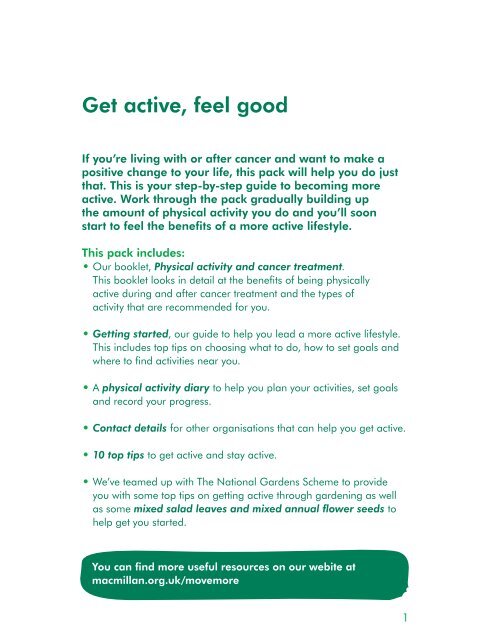
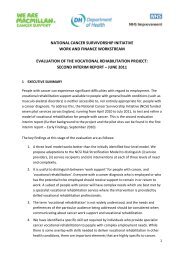
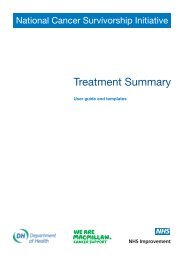

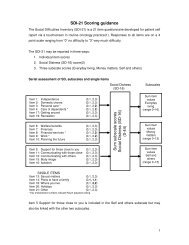
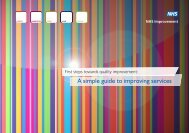
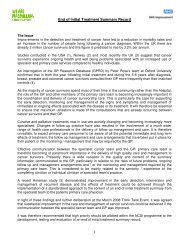
![Download the how to guide [PDF] - Macmillan Cancer Support](https://img.yumpu.com/47067428/1/184x260/download-the-how-to-guide-pdf-macmillan-cancer-support.jpg?quality=85)
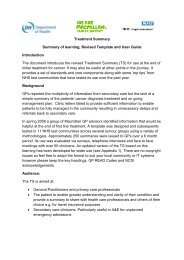

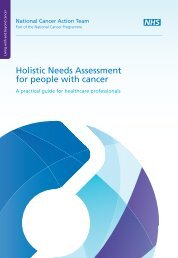
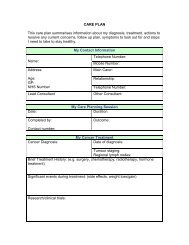

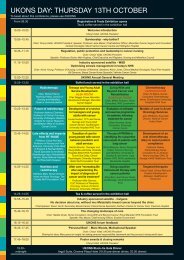
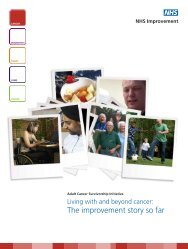
![HOPE Protocol [PDF, 420KB] - National Cancer Survivorship Initiative](https://img.yumpu.com/32566432/1/184x260/hope-protocol-pdf-420kb-national-cancer-survivorship-initiative.jpg?quality=85)